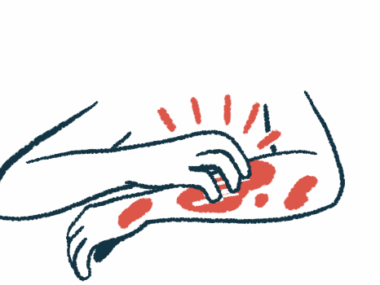Learning to give grace to our sometimes mercurial 4-year-old
With Alagille and its itch atop some challenging years, our son needs our help
Written by |

Saying that 4-year-olds can have crazy attitudes is not a groundbreaking statement. It’s not unusual for my son Finley to have wild swings from happy to angry and back again all within the span of a few minutes. Learning to be a human is hard work, and 4-year-olds are truly in the thick of exploring what it means to push boundaries, have feelings, and navigate their day-to-day experiences. With Alagille syndrome added to Finley’s story, some extra hurdles contribute to his learning process.
First and foremost on my mind is the itch, or cholestatic pruritus, one of the visible components of my child’s liver disease. I’ve written about it quite a bit, and it remains a focus of my parental care, as I want to ensure Finley has his medication and that we’re taking steps to keep him comfortable. I know the itch cannot be pleasant. And I know it affects his mood.
Recently in my column I touched on taking steps to prep for the warmer weather and how it relates to Finley’s care. Today’s column is more about the general, daily reminders of what I need to do.
Keep calm and problem-solve
The biggest one is remembering to give Finley grace. When he’s feeling irritable, what can I do to support him? It’s not always an easy task. Whether it’s getting him to bed or leaving for school on time, I find it tough to stay calm.
To help, I’ve tried to focus on putting myself in his shoes. What’s making him react this way? Is the reaction worse because he’s itchy? Is he more hungry than angry? All of these scenarios take work to reach an answer or, better, a solution. It’s easier to write than put into play, especially when I’m tired and at a tipping point of patience. But I’m trying.
Bedtime has been tough for Finley the past few months. Over the past few weeks we’ve worked to alter the routine to make that time of night more pleasant for everyone.
One of our biggest successes has been his nightly coloring. For about 15-20 minutes, Finley and his brother, Jackson, spend time coloring while we play some music. It’s been a great calm-down period before starting the steps to bedtime.
In hindsight, it seems so simple to add a step like this one. But when time is a precious resource, and one that a working parent with busy kids doesn’t have enough of, the initial thought to extend the bedtime period wasn’t so appealing. In practice, it’s been a major success.
The biggest takeaway from this success is the need to be amenable to changing routines — such as giving him time and space to work through his feelings and emotions. In addition, we have to remember the underlying components of liver disease and how those may be affecting him.
It’s an adventure to assess how our day with Finley might go, but my job is to make the day easier for him to navigate.
Note: Liver Disease News is strictly a news and information website about the disease. It does not provide medical advice, diagnosis, or treatment. This content is not intended to be a substitute for professional medical advice, diagnosis, or treatment. Always seek the advice of your physician or other qualified health provider with any questions you may have regarding a medical condition. Never disregard professional medical advice or delay in seeking it because of something you have read on this website. The opinions expressed in this column are not those of Liver Disease News or its parent company, Bionews, and are intended to spark discussion about issues pertaining to liver disease.









Leave a comment
Fill in the required fields to post. Your email address will not be published.